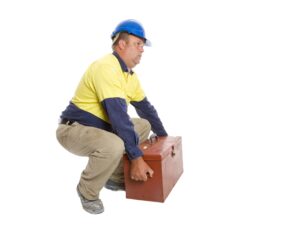This guide aims to answer the question, ‘what are the best manual handling and lifting techniques?’. It is important to use the correct lifting techniques when carrying out a manual handling task, as failure to do so could result in you sustaining an injury. If your injuries are caused by failings on the part of your employer to uphold the duty of care they owed to you, you could be eligible to make a personal injury claim.
As we move through this guide, we will examine which lifting techniques are recommended when carrying out manual handling tasks at work. What’s more, we will explain the duty of care that employers owe to their employees, and discuss the steps you could take if this is breached, causing you to sustain an injury. Then, we will look at how compensation could be calculated in a successful manual handling accident at work claim.
If you have any questions that you would like to ask, you can get in touch with a member of our friendly team at any time. They are available 24/7 to provide free advice on making a personal injury claim following a manual handling accident at work. There is no obligation to further your claim with us.
You can:
- Call our team on 0161 696 9685
- Contact us via our online form
- Use the live chat feature on this page
Select A Section
- What Are The Best Manual Handling And Lifting Techniques?
- Who Could Claim For A Manual Handling And Lifting Injury At Work?
- Examples Of Workplace Manual Handling Injury Payouts
- Could A No Win No Fee Solicitor Help You?
- Learn More About Safe Manual Handling At Work
What Are The Best Manual Handling And Lifting Techniques?
Manual handling at work is sometimes necessary to transport goods from one place to another using bodily force. The Health and Safety Executive (HSE), the regulator of workplace health and safety in Britain, provides advice on good manual handling techniques. They state that it is the responsibility of employers to protect their employees from the risk of sustaining manual handling injuries at work.
In the following sections, we will discuss the HSE’s advice regarding good handling techniques.
Good Lifting And Handling Techniques
The HSE outlines some steps that you can take to ensure you are using good lifting and handling techniques. These are as follows:
- Plan the activity
- Ensure you keep the load close to your waist
- Get into a stable position with your feet apart
- Get a good hold on the load
- Slightly bend at the start of the lift
- Do not flex your back any more when lifting
- Do not twist your back
In the following section, we will explain the techniques you can use to help you safely carry a load.
How To Carry The Load
The HSE also provides further guidance on carrying a load in the workplace. This is as follows:
- Don’t lift or handle more than you can manage
- Keep your head up
- Move smoothly
- Place the load down and then adjust
You may wonder, ‘what if I am pushing or pulling a load in the workplace?’. We will provide advice on this in the next section, so continue reading.
Safely Pushing And Pulling Loads In The Workplace
Pushing and pulling loads via a trolley or pallet truck is a way of moving a higher volume and weight of goods whilst also reducing the necessary amount of manual lifting and carrying. It is still important that health and safety procedures are put in place, to ensure that the employees carrying out pushing and pulling operations are safe, as far as is reasonably practicable.
We hope this has helped to answer the question, ‘what are the best manual handling and lifting techniques?’. Please continue reading to find out whether you could make an accident at work claim for a manual handling injury.
Who Could Claim For A Manual Handling And Lifting Injury At Work?
You could be eligible to make a personal injury claim for a manual handling and lifting injury at work on the basis of employer negligence. Negligence means that:
- Firstly, your employer owed you, their employee, a duty of care at the time and location of your accident.
- Secondly, your employer breached this duty of care.
- Finally, as a consequence of this breach of duty, you sustain physical injuries and/or mental harm.
You may wonder, ‘what is the duty of care that employers owe to their employees?’. As laid out in the Health and Safety at Work etc. Act 1974 (HASAWA), employers must take all reasonably practicable steps to ensure their employee’s safety and welfare at work. This includes performing risk assessments and providing adequate manual handling training.
Also, as per The Manual Handling Operations Regulations 1992, employers must avoid a manual handling task, as much as is reasonably practicable, if it presents the risk of their employees being injured. However, where it cannot be avoided, an employer must assess the risk and reduce it to the lowest level reasonably possible.
Manual Handling Accident Claim Limitation Periods
The Limitation Act 1980 sets out the applicable time limits to personal injury claims. It states that legal proceedings must be started within three years of the date that your manual handling accident took place. Although some exceptions can apply in certain circumstances.
Please speak to a member of our team to learn whether you could be eligible to make a personal injury claim against your employer. They can provide insight into the limitation period for your claim.
Examples Of Workplace Manual Handling Injury Payouts
A successful manual handling injury payout could comprise up to two different types of damages. These are called general damages and special damages.
Firstly, general damages account for the pain and suffering caused by your physical injuries and/or any mental harm sustained. This also considers the impact of your injuries on your quality of life.
As an aid when valuing general damages, personal injury solicitors can use the Judicial College Guidelines (JCG). Therefore, we have used this document to create the following table containing guideline compensation brackets for various injuries that could be sustained in a manual handling accident.
Guideline Compensation Table
| Injury Type | Severity | Notes on the Injury | Guideline Compensation Bracket |
|---|---|---|---|
| Back Injury | (a)(i) Severe | The most severe injuries involving nerve root damage and spinal cord damage. | £91,090 to £160,980 |
| Back Injury | (a)(ii) Severe | Cases with features such as damage to the nerve roots with connected sensation loss, mobility impairment and further problems. | £74,160 to £88,430 |
| Back Injury | (a)(iii) Severe | Instances, of soft tissue injuries for example, that lead to chronic conditions where disabilities remain after treatment. | £38,780 to £69,730 |
| Back Injury | (b)(i) Moderate | This bracket contains various injuries where residual disability is of a lesser severity than in the bracket above. | £27,760 to £38,780 |
| Back Injury | (b)(ii) Moderate | Frequently seen back injuries, for example, prolapsed discs that require a laminectomy. | £12,510 to £27,760 |
| Arm Injury | (c) Less Severe | There were significant disabilities but a substantial level of recovery took place or will be expected to do so. | £19,200 to £39,170 |
| Wrist Injury | (c) Less Severe | There will be some disability that is permanent. For example, some degree of stiffness and persisting pain. | £12,590 to £24,500 |
| Wrist Injury | (f) Very Minor | Very minor minimally displaced or undisplaced fractures. There will be a full or virtually full recovery within up to 12 months or so. | £3,530 to £4,740 |
| Shoulder Injury | (b) Serious | Lower brachial plexus damage and shoulder dislocation causing pain, aching and weakness of grip. | £12,770 to £19,200 |
| Shoulder Injury | (c) Moderate | A frozen shoulder, where symptoms persist for around two years. | £7,890 to £12,770 |
This table is a guide, as each manual handling accident case is unique.
How To Calculate Special Damages
The second head of claim that you could receive is special damages. This reimburses for the monetary losses stemming from your injuries, both past and future.
This could include:
- Loss of earnings
- Travel expenses
- The cost of care
- Housing adaptations
It is important to note that you would require evidence of these losses, such as payslips, travel tickets and invoices.
Would you like a member of our team to provide you with a compensation estimate personalised to you and your case? If so, get in touch today.
Could A No Win No Fee Solicitor Help You?
It can be beneficial to use a solicitor to make a manual handling injury claim, as they can help guide you through the claims process. What’s more, under a type of No Win No Fee agreement, known as a Conditional Fee Agreement (CFA), you can access their services without being required to pay any upfront or ongoing fees for these services.
What’s more, you also usually will not pay for the services of your solicitor in the event your claim is unsuccessful.
Although, No Win No Fee solicitors can, in the event of a successful personal injury claim, take a small percentage of the compensation. The relevant legislation caps this success fee, however. Therefore, you know you will not be overcharged.
Speak to one of our team members for an assessment of your manual handling accident claim. If they find that you could have valid grounds to pursue compensation, they may place you in contact with one of our No Win No Fee personal injury solicitors.
Get In Touch With Our Team
Please don’t hesitate to reach out to our team and ask questions relating to this guide on, ‘What are the best manual handling and lifting techniques?’. They can provide advice on making a manual handling injury at work claim.
You can:
- Call our team on 0161 696 9685
- Contact us via our online form
- Use the live chat feature on this page
Learn More About Safe Manual Handling At Work
Firstly, take a look at more of the guides on our website:
- How Can Manual Handling Claims Solicitors Help Me?
- How To Claim For A Back Injury At Work From Lifting
- Could I Claim Compensation For A Part Time Staff Accident At Work?
Then, explore the external links below for further support and information:
- HSE: Manual Handling – Reduce the risk of injury
- HSE: Back pain
- GOV.UK: Statutory Sick Pay (SSP)
Thank you for reading this guide, we hope to have answered the question, ‘what are the best manual handling and lifting techniques?’.
Written by JO
Edited by FS


